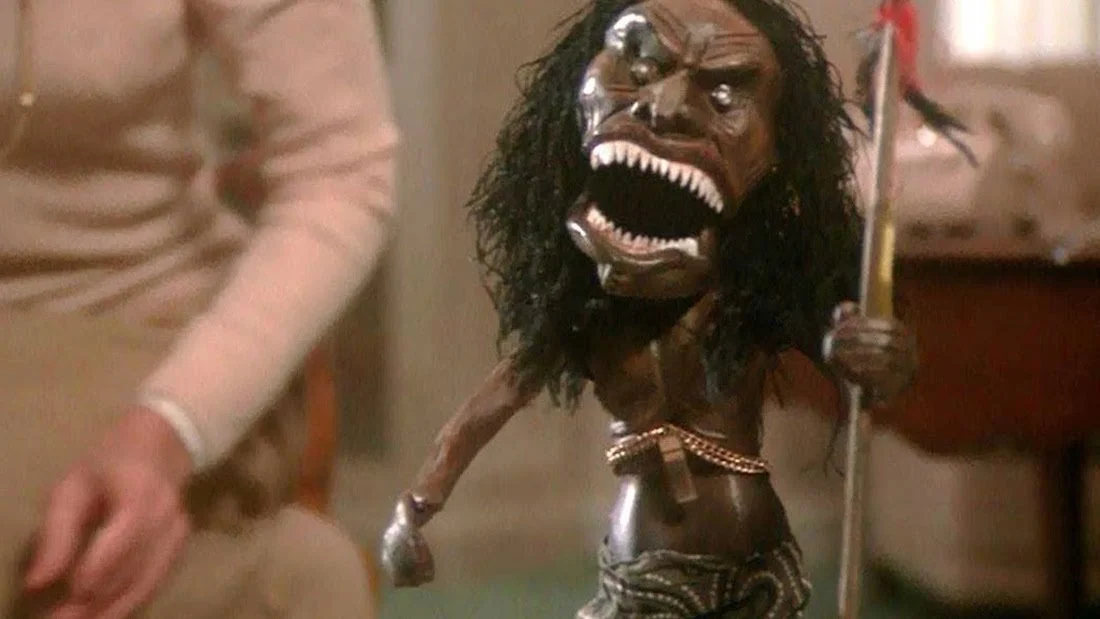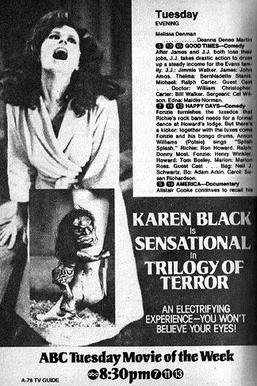TRILOGY OF TERROR (1975)
I just got the weirdest idea… watch a whole bunch of doll-centered chillers to celebrate a brand new horror movie holiday called Doll-O-Ween! Wait a minute, that wasn’t my idea! That was the brainchild of my benevolent benefactor and editor Rob Dean. Dammit, Rob! You Julincepted me! Don’t worry if you didn’t laugh at that last sentence. It’s funnier after you see what MeTV’s Svengoolie called “the scariest made-for-tv movie of all time,” the 1975 ABC horror anthology TRILOGY OF TERROR.
For a lover of horror anthologies, this trio of trepidation tales is required viewing. To the uninitiated, this film can probably be distilled to the singular image of a diminutive dagger-tooth doll wreaking havoc on a terrified young woman but that’s the cherry on top. That’s for dessert. If we’re really gonna chew the fat on TRILOGY OF TERROR, let’s make a proper meal out of it and slice up each segment piece by piece but be advised, in deconstructing this triumvirate of dread there will be spoilers so if you want to watch it first, I can wait for you here. It’s only 72 minutes long [looks at fake wristwatch expectantly] so while you catch up with the rest of the class I guess I can probably go return these videotapes.
You back? Great! Let’s get into it! TRILOGY OF TERROR premiered as an ABC Movie of the Week broadcasted on Tuesday March 4th, 1975 at 8:30 PM eastern standard time. With a lead-in from meteoric ratings giant Happy Days ensuring that millions of American homes could conceivably ride Fonzie’s leather coattails into a trio of televised horror the likes of which would be remembered for decades to come. Pretty good considering one segment was a lower budget rush production and the other two were unsold pilots for a forthcoming horror anthology tv series starring Ed Begley Jr. entitled Dead Of Night. Not to downplay the writing and direction of Richard Matheson/William F. Nolan and Dan Curtis respectively, but what carries these stories beyond their rather inauspicious origins are the varied powerhouse performances from the star of all three vignettes, Karen Black. Horror hounds may recognize her as the malicious matriarch of the Firefly family in Rob Zombie’s HOUSE OF 1000 CORPSES (2003). Now that’s range!
So let’s sink our teeth into our movie meal here and start on the soup and salad. The first story entitled “Julie” is tonally reminiscent of true crime tales of the era with a slight supernatural slant. Think LOOKING FOR MR. GOODBAR (1977) with a siren subtext. We follow this creepy collegiate chowderhead Chad as he drugs, assaults, and takes tawdry photos for the purpose of blackmailing his seemingly conservative literature professor, Ms. Julie Eldridge, only to find himself a pawn in her own malevolent machinations. While not narratively groundbreaking there’s satisfaction to be had with Chad’s comeuppance and watching Karen Black’s Juile character shift from meek and mousy to Machiavellian is quite the sight to behold. Didn’t I tell you about her range?
For our entree we get two meaty performances as Karen Black portrays disparate dueling roles in “Millicent and Therese.” This tale harkens back to Hitchcockian thriller tropes in a second serving of psychological suspense. Through a series of cryptic conversions with the family psychiatrist we think we’re getting a perilous play on THE PARENT TRAP (1961) but we actually get a sisterly slant on PSYCHO (1960) with a dollop of voodoo. Karen Black really gets to show off her acting chops with contrasting makeup, costuming, and character voices volleying between the prudish and pious Millicent and the prurient party girl Therese while each attempt to gain the confidence of George Gaynes of POLICE ACADEMY (1984) fame. We talked about her range, gang. What could demonstrate more range than this?
Well, those plates look clean enough. I suppose it’s time for your dessert. “Amelia,” the Viennetta Ice Cream Cake of made-for-TV horror anthologies, is served. Rather than just doing the yeoman’s work, Karen Black carries the entirety of the narrative this time in what is ostensibly a one woman show aside from some puppeteers and the shrill screams of Frank Welker (better known as the voice of Megatron from The Transformers cartoons) as the Zuni fetish doll. The Twilight Zone flavor is strong with this segment which stands to reason since writer Richard Matheson wrote several episodes of that program including “Nightmare At 20,000 Feet,” where William Shatner tangles with a gremlin on the wing of a commercial airliner, so it’s clear he knows his way around a narrative starring a rowdy little hellion. The Zuni coming to life felt largely organic and the shots from the doll’s perspective add to the unnerving chaotic panic to the proceedings.
And can we talk about the design for the Zuni doll? Standing at just over a foot high, this little wooden monster was an original production for the purpose of the film and is just about the most racist interpretation of an aboriginal warrior you could get. Arguably the offensive nature of the doll makes it that much more terrifying as a foe and an even less sensible gift for an anthropologist. I’m no professor but it bears mentioning that Zuni isn’t African but rather a Pueblo Native American tribe traditionally based out of the American Southwest, but the important thing here is we get an awesome knockdown, drag-out fight between a demure debutant and a savage doll containing several scenes relatable to anyone who’s ever attempted to train an overly aggressive puppy. Particularly the part where the Zuni doll is slashing a steak knife underneath the bathroom door.
Amelia and Zuni engage in a surprisingly bloody battle for network television with Amelia tapping into her own inner savagery in the confines of the claustrophobic yet plush high-rise apartment. We get jumpscares and great tension with never quite knowing where the Zuni doll is or what instrument of torment that wooden bastard has gotten his grubby, little hands on. And we’d be remiss to not mention the iconic scene that was actually the brainchild of Karen Black herself. After Amelia incinerates the doll in her oven, thus releasing the trapped warrior spirit inhabiting the figure, she crouches in the wreckage of her once luxurious flat, knife in hand, awaiting the arrival of her domineering mother, and brandishing dagger sharp teeth exactly like that of the Zuni doll to demonstrate her current state of possession by the ancient hunter known only as “He Who Kills.” See, I wasn’t just foolin’ with y’all. We get some real range here people!
Ultimately TRILOGY OF TERROR consists of three allegorical tales on the duality of womanhood in western society [whispers “range” one last time]. Julie appears weak and soft, easy prey for Chad but is actually a predator herself, very much in control of her body, sexuality, and quite prepared to make any number of men the target for her dark appetites. Millicent and Therese manifest this female dualism again by splitting a single person into two combating identities that are typified by a patriarchal delineation of female personality traits of either virgin or whore. Amelia’s story cuts out the subtlety but having a docile and subdued woman become literally inhabited by a wild warrior spirit while heavily hinting at the savage actions to come. “Julie” and “Millicent and Therese” don’t quite have the immediately recognizable iconography of “Amelia,” all three are satisfying servings of primetime suspense. While the through line for this trio of terrifying televised tales is an exploration of the duality of woman, it's done so through a male perspective providing agency for the female leads but lacking in depth. Pleasurable viewing but not revolutionary by 2023 standards but as a product of 1975 network television you're not going to get too much more in the way of subversive gender politics is your creepy compendium. And need I remind you of the range?





